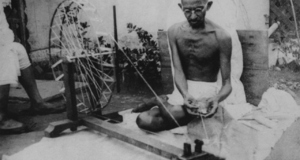Featured Article:Anxieties of Empire: Examining Frontier Governance in 19th Century British IndiaIn a letter to the Peshawar Commissioner in early 1886, the Secretary of Punjab, W.M Young, expressed deep concern about the “the present lamentable prevalence of homicide and murder.” Basing his observations and recommendations on information supplied by key officers in the Peshawar Division, including the Lieutenant Colonel, he expressed with grave concern that the problem of crime persists in the Frontier and that special measures that had been tried hitherto were clearly inadequate. The annual average numbers of murders were 43 and 27 in 1862 and 1863 respectively. This figure increased to 73 in 1884. The Indian Penal Code and the Code of Criminal Procedure came into effect in 1861 but the Secretary notes “with the greater elaboration of the judicial machinery the number of murders actually increased.” In the ten years between 1875 and 1884, there were 676 incidents of murder out of which the law failed to address 440 cases. This situation presented an intolerable degree of insecurity. According to the Lieutenant-Governor, the problem could not be wholly explained by the inefficiency of the administrative staff. In his opinion, “the true causes of the evil lie in the social condition of this peculiar part of the country and the rigid demands of our system of law.” British law was based on the evidence and on thus on the assumption that evidence would be forthcoming and available. But it is argued, that this is not the case in the Frontier. “Now with the Pathans, revenge is a point of honor, it is a point of honor to screen partisans; murder in certain cases is not only viewed with indifference but with approbation…while it is ignominy to leave a slur on the family honor unavenged.” The means of remedying this state of affairs must take cognizance of the true cause of the problem.29 Having argued as such, the letter goes on to delineate the nature of the remedies and in doing so provides the blueprint for the second version of the Frontier Crimes Regulation which would be enacted in 1887. The proposals include alterations to the law itself as well as an increase in administrative powers. The Punjab Frontier Crimes Regulation 1887 enlarged the powers of the administrative authority, in accordance with the recommendations of the officers serving in the Frontier. The District Magistrate could be vested with the powers of the Deputy Commissioner. This allowed him to exercise both administrative and judicial powers. The Deputy Commissioner could discern cases of dispute based on police reports “or other information” and forward such cases to the Council of Elders, even when there was no official suit filed by either party.30 The Council of Elders still acted as a recommending body with the Deputy Commissioner having the final say. Based on the findings of the Council, the Deputy Commissioner could make the decision on whether to proceed with the findings; conclude the case or pass a decree on the matter being discussed.31 Furthermore, the Commissioner and Deputy Commissioner were now equipped with the power to decide whether a criminal case should be decided by regular courts or depending on expediency, referred to the Council of Elders on whose recommendation the Deputy Commissioner could take the final decision.32 This power could be exercised at any point before the commencement of the trial.33 During a trial, the Public Prosecutor may be asked to withdraw the case and refer the case to the Civil courts could not exercise jurisdiction on such cases.34 The fact that technicalities of the law and rigors of the legal procedure were discounted from the whole process did not affect the legitimacy of the outcome in the eyes of the law. All decisions based on the findings of the Council of Elders and taken by the Deputy Commissioner carried the same weight and legality as did a decision of regular court35. However, no decision or decree passed under this law would be subject to appeal. The right to revision lay solely with the Commissioner who may revise a decree if he deems it be against public policy or “good conscience.”36The Regulation continued with the tradition of applying draconian punishments on the local population. Collective punishments were considered effective and necessary. The Deputy Commissioner could impose blockades on any tribe considered to be hostile to the British government as well as “detain all members from that community, debar members of the tribe from access into British territory and prohibit British subjects from all intercourse with the tribe.”37 He also had the power to impose fines on any village community or part of the community if they are found to be providing refuge to criminals.38 One of the recommendations alluded to by the Punjab Government to the Peshawar Division was to take active steps to prevent crimes. These preventative measures allowed for the British authorities to curb basic freedoms and increased their executive powers manifold. Communities could not erect no new buildings and make no new settlements without the prior knowledge and consent of the Commissioner.39 The local government could order the removal of a village on the immediate border to any other site and it could ask any person believed to be part of a dispute to leave British territory.40 Any private person may be arrested without warrant and without an order from the Magistrate and handed over to the police. This person could be involved in a cognizable offence but the arrest could be made on the basis of information and suspicion as well.41 The Deputy Commissioner was also endowed with the power to order a person or a family to execute a bond of good behavior with or without sureties. This forced agreement would ensure the loyalty and obedience of the subject party.42 Should the person not comply, he is liable to fines, imprisonment or other punitive measures.43 In the years following the promulgation of this law, administrators hailed it as a crucial to the maintenance of security in the region. Administrators pushed higher authorities to increase the powers of the executive still more. A lengthy report by the Frontier Crimes Regulation Committee issued in 1899 called for a series of amendments which would do precisely that. A few examples shall illustrate the point. The committee concluded that the law as it stood only kept British subjects from interacting with a tribe which has been placed under blockade. “There seems to be no reason why aliens committing the same offence should not be treated in a similar fashion.”44 It also called for further control of communal institutions particularly the “hujra.” The hujra was a sort of clubhouse for young men of the village. The report notes that there should only be one official hujra under the village Lambardar (a village officer appointed by the government). The committee concluded that the construction of other hujra’s takes away from the power of the Lambardar and that such “obnoxious hujras”45 should not be allowed46. The report also takes cognizance of the issue of fanatical “Ghazis.” Since the early 19th century, the British had been faced a threat from “Hindustani Fanatics” committed to the jihad. The phenomena began in the 1820s when Sayyid Ahmed of Rai Bareilly led the call for jihad against the Sikh suzerainty47. The British were well aware of their presence when they came to power in 1849. After the Indian Mutiny of 1857, the term “fanatics” gained the negative connotation it has had since then.48 In the report being discussed, the committee notes that the “experience of the frontier disturbances has shown the necessity for enlarging greatly the Deputy Commissioner’s power to remove persons from trans-Indus districts.” A trans-border Pathan Ghazi is not distinguishable from the rest of his tribe. Should the authorities find such a person in the settled districts they should have the power to remove and punish him. This section goes on to point that these “mullahs and persons belonging to the obnoxious class known as talib-ul-ilm roamed about the Peshawar and Kohat Districts, exciting the villagers and preaching the doctrines that the service of Government of India was heresy…The presence of the dangerous fanatic and the dangerous alien in our border villages promotes disloyal excitement which leads men on t the espouse the cause of our enemies or to commit murderous outrages upon British subjects.” The report concludes that the Deputy Commissioner should be armed with the power to banish such dangerous persons and that they be considered involved in the “dissemination of sedition”49. Most of the committee’s recommendations were implemented and requisite additions or changes made in the 1901 version Frontier Crimes Regulation, including one for the punishment of “fanatics.”50 It can be noted that preponderance with order animated the management system of the Frontier. According to contemporary observers and scholars, managing this area was more than just “good governance, it was an integral part of the imperial security. Correspondence amongst officers and administrative literature reveals an obsession with the maintenance of control and British domination at the cost of British standards of law and governance. Disorder in a space which had been characterized with an absence of state-penetration had to be avoided at all costs. The virtues of the British law were much less important. “Our civil law and procedure unsuitable for tranquility of the frontier,” reads a correspondence within the Foreign Department, “the object is not to avert litigation, but to preserve the tranquility of the frontier...The system (of Border Military Police) has been undertaken with a view to the peace of the border. Reports of the past four years will show that the practice of “bota,” “baramata” and other border crime has almost, if not altogether, ceased where the system has been in force….”51 The legal ethos that governed the Frontier, with an insistence on the use of brute force and executive authority, stood in direct contradiction to the dominant British legal paradigm, that of utilitarianism, in India.Continued on Next Page » Suggested Reading from Inquiries Journal
Inquiries Journal provides undergraduate and graduate students around the world a platform for the wide dissemination of academic work over a range of core disciplines. Representing the work of students from hundreds of institutions around the globe, Inquiries Journal's large database of academic articles is completely free. Learn more | Blog | Submit Latest in History |


















